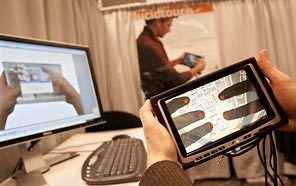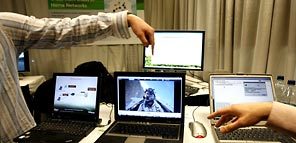Wednesday, March 5, 2008 - Page updated at 06:44 AM
![]() E-mail article
E-mail article ![]() Print view Share:
Print view Share: ![]() Digg
Digg ![]() Newsvine
Newsvine
One big science fair for hundreds of Ph.D.s
Seattle Times technology reporter
ALAN BERNER / THE SEATTLE TIMES
Microsoft researcher Patrick Baudisch, seen in the poster at rear, demonstrates the solution to the "fat-finger problem" by using pinpoint, fingertip control on the back of a touch screen. The program, LucidTouch, is being shown to visitors at TechFest on the company's Redmond campus.
Microsoft researcher Christos Gkantsidis was playing Xbox Live when an application on another computer attached to his home network started gobbling up bandwidth. The game froze. Not OK.
"The network needs to solve its own problems itself," he said.
He expects more people to face similar traffic jams as home wireless networks become crowded with computers, and family members compete for limited bandwidth to stream videos, make online phone calls and download files.
Gkantsidis and colleagues at Microsoft Research in Cambridge, England, set to work on HomeMaestro, an application that sets priorities on certain activities — such as games or videos that need uninterrupted, high-speed connections — and slows down others to optimize the available bandwidth.
HomeMaestro isn't a Microsoft product yet. But it could be on its way later this week, when more than 6,000 employees tour the company's annual internal science fair, TechFest.
Over the past 16 years, Microsoft has hired many of the world's best computer scientists and told them to follow their curiosity with no worries about profits or deadlines. There are now more than 800 Ph.D.s working at seven sites around the world.
The company wants to take best advantage of their research to improve existing products and invent new ones. But because of the size of Microsoft Research (MSR) and the company as a whole, pairing up research advances with product groups can be challenging.
For the past seven years, MSR has sought to bridge that gap with TechFest. Today and Thursday, employees will visit exhibits on the Redmond campus highlighting 150 research projects.
The company opened a scaled-down version of its TechFest to reporters and outside academics Tuesday.
Rick Rashid, the longtime head of Microsoft Research, said he was skeptical when TechFest was first proposed, but the benefits were quickly apparent. Not only did it open lines of communication between MSR and the rest of the company, the event had a positive impact on morale.
"This made our employees feel good about Microsoft," Rashid said. "It made them feel proud of what we were doing, and the long-term investments that we were making."
Rashid boasts one of the largest basic-research divisions in the corporate world. Most, if not all, Microsoft products have at least some piece of technology derived from his division, he said.
![]()
MSR also helps the company identify emerging competitive threats.
"We're a great early-warning system," Rashid said. "We'll say things like, 'You know this Internet search thing, it could be big some day.' People don't always listen to us."
Many of the projects on display in Redmond focus on Internet search, an area where Microsoft trails Google.
GeoLife, a project from Microsoft's lab in Beijing, uses mobile devices and cameras enabled with global positioning systems to automatically create a log and multimedia presentation chronicling a person's travels through a city. The log is displayed on a map that could be shared with a friend.
A tourist in Beijing, for example, could select an area of the city on the map and search for information. Other people's travel logs from that area could be returned as results.
The U.S. presidential election inspired another effort. Blews is a political news tool that tracks stories generating the strongest responses from bloggers. The software tracks whether responses come from liberal or conservative blogs and analyzes blog text to determine whether a story is firing up the right or the left.
The idea is to help identify stories drawing attention from different parts of the political spectrum.
"It's very easy as an individual to get locked into reading just one news source that always agrees with you," said Sumit Basu, a Microsoft researcher working on the project. "You think you're getting a complete picture, but you're not really."
Microsoft also collaborates on research that seems far removed from its business interests. One that has drawn lots of attention is the WorldWide Telescope, an application due in spring that stitches together images from telescopes around the world to give the fullest picture yet of the night sky.
Users will be able to zoom in on any point in the sky, discovering distant galaxies that only astronomers see on a regular basis.
Actor Alan Alda, who hosts the PBS show "Scientific American Frontiers," said he was amazed by the technology. One feature allows users to narrate their own tours of the night sky. He listened to one created by a 6-year-old boy.
"You hear this 6-year-old voice with all this enthusiasm, and the wonder of a child, leading you through the universe in a knowledgeable way," Alda said in an onstage discussion Tuesday.
"... It was a great moment because you saw in that brief tour a hint, a smell of what the impact of something like this can be in terms of education and in terms of the communication of science."
Benjamin J. Romano: 206-464-2149 or bromano@seattletimes.com
Copyright © 2008 The Seattle Times Company
| Get home delivery today! |

New home & condo listings at NWhomes
Find a home that fits your lifestyle
• New construction communities
• Builder directory
• Interactive maps & floor plans
- Sorry, Hillary: You've crossed the line | Guest columnist
- Suddenly, M's are f-f-favorites in AL West | Larry Stone
- Train crashes into semi-truck at crossing near Marysville, derails; Amtrak buses passengers to Bellingham, Canada
- Huskies will host Valparaiso in CBI tournament
- Call Girl Laments Use of Exotic Photos
- ON DEADLINE: Obama Walks Arrogance Line
- Fed Aggressive on Financial Front
- Denver delivers the Sonics' worst loss
- NCAA Tournament | Time to put your best bracket forward | Steve Kelley
- Goal is getting critters out of shelters — alive









